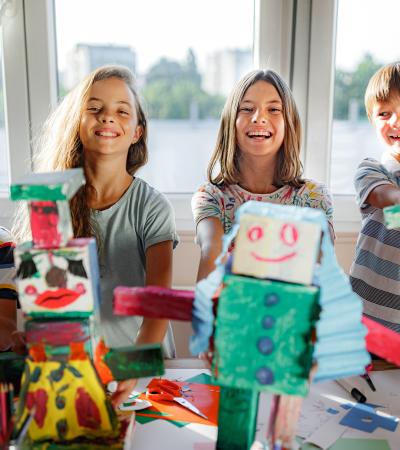Localvore Club began as a collaboration between special education teacher Melissa Bryant and me, librarian Gail Brisson, at Russell I. Doig Middle School in Trumansburg, N.Y. Mrs. Bryant noticed that her students were frustrated with the text-heavy work in their English Language Arts (ELA) classes. They were intrigued with "The Omnivore’s Dilemma" by Michael Pollan and "The Big Thirst" by Charles Fishman but were having a hard time connecting with the ideas.
Once the students expressed that they wanted to do more hands-on work, Mrs. Bryant and I put our heads together and developed the Localvore Club. In this club, students created a weekly lunch for staff members using locally sourced ingredients. Lunches were served in the library each Thursday during fall 2015.
Advanced Planning
We starting planning for Localvore Club in summer 2015. Mrs. Bryant made contact with Plowbreak Farm, a local CSA (community supported agriculture) whose owners agreed to donate extra produce to our program. We also recruited several volunteers who would be at school on Thursdays to help set up, serve and clean up.
Once we'd presented the program and gained approval from our principal, we worked through the logistics of using the home and careers kitchen, researched menu options and aligned our program goals with New York State learning standards.
Marketing
One of the first tasks we gave to students was to market and promote the Thursday lunches. (View a sample menu under Attachments at right.) The students learned to use Google Docs to create posters, which they distributed to all staff members. We also created a blog, Tburg Cooks Local, that students and teachers contributed to and that we promoted through the school's Twitter feed.
The marketing efforts were very successful. We regularly sold lunches to about half of our 60 staff members.
Budgeting
Localvore Club was lucky enough to to receive a $1,500 grant from the Trumansburg Central School District (TCSD) Foundation. This was used to purchase ingredients to cook the weekly lunches. In addition, local farms, gardeners and beekeepers donated produce and honey for students to cook with. Staff members also donated about $5 each time they attended a lunch event.
If lunches were offered monthly or quarterly, instead of weekly, this program could be run on a smaller budget. Donations from local farmers and gardeners can also help reduce costs.
Day-of-event Activity
Localvore Club lunches were offered weekly on Thursdays. Students cooked Monday through Wednesday with Mrs. Bryant, Ms. Brisson, teacher aides and sometimes other teachers or volunteers. On Thursday mornings, two volunteers would come to help set up dining tables in the library and make final food preparations. Students helped to serve lunches, and our volunteers cleaned up at the end of the lunch periods.
While we didn't conduct a formal assessment of Localvore Club, staff and student reaction was overwhelmingly positive and supportive. I don’t think we expected the outpouring of support we’ve received since launching the Localvore Club. Support has come from parents asking how they can help expand the program; teachers offering their favorite recipes; and local farmers and producers donating produce and expertise. We feel that offering students the opportunity to cook has opened some larger and more exciting opportunities that will lead to changes in the way we are able to teach and learn. Middle-school students love hands-on projects and working in real-life situations, and we have been lucky enough to see their enthusiasm for Localvore Club.
Localvore Club has pushed our library in new and unexpected directions. Collaborating with Mrs. Bryant and hosting our lunches in the library has meant that almost every staff member has spent more time in the library, giving us time to connect and discuss other project possibilities. The project has meant that parents, administrators and community members have seen that a school library is more than a room full of books — that it is a learning laboratory, which adapts to the needs of our students and staff. Since beginning Localvore Club, the conversations and enthusiasm have led to other projects in which the library has played a role (e.g., a Zambian sister school initiative, STEM Career Day, a campus-wide food and cultural celebration next year).
Program Execution
While the core of Localvore Club was a small number of students (fewer than 10 initially) the immediate response from students and staff prompted us to expand it. As students came through the library on Thursdays and saw the Localvore lunches, they began to ask how they could be involved. We quickly strategized with our home and careers teacher to involve every grade level in cooking foods connected to their ELA readings.
Funding from the TCSD Foundation helped purchase ingredients, and TCSD Foundation board members came by to enjoy some of the lunches. In November 2015, we held a large harvest celebration, which had upper administration, board of education members, TCSD Foundation board members and parents attend a festive lunch. While we couldn’t feed the whole school, we made “mystery vegetable” cupcakes that were available for students to taste. Only one student was able to guess that celery root was the mystery ingredient!
The success of the Localvore Club has brought many new opportunities for collaboration both within the school and in the larger community:
- Technology teacher Eric Yettru is working with his STEM enrichment class to build a bicycle cart (complete with a burner and blender) that Mrs. Bryant can pedal to school and community events. This will allow students to offer smoothies and other treats to attendees.
- Local beekeepers, cheesemakers, farmers and gardeners have all offered to work with students as the program continues to grow. In the spring of 2016, a Cornell student worked with us to create a hydroponic growing system in Mrs. Bryant’s classroom.
- As of August 2016, we have raised $1,000 for the installation of a donated hoophouse. This means students will be able to start growing food on campus throughout the school year. By making lunches and investigating our local food system, students are building community and connections.
The most immediate impact of Localvore Club, though, was student engagement. Mrs. Bryant immediately noticed that her students were more engaged; there were fewer disciplinary referrals and attendance definitely improved. They were also more willing to take on new and different tasks and were engaging with their reading at a new level. The book "Omnivore’s Dilemma," which had seemed so abstract and difficult to them, suddenly seemed to be talking about their very own project! Instead of groaning about doing research, they eagerly came into the library and improved their searching skills. They learned how to write and support a claim, wrote blog entries and developed presentation materials.
Localvore Club has helped our students develop higher-order thinking skills using real-world situations. For example, when researching a cheese or yogurt recipe, they had to compare ingredients and steps to find recipes that would work within our time and space restrictions. They also had to compare and contrast different recipes and discover the ways in which final products of these recipes worked or didn’t work. The core group of Localvore Club has been students who often struggle with reaching higher-order thinking skills. Our focus on a hands-on, real-world, food-based project helped them step up and take charge of their learning.
Localvore Club took our library way beyond traditional library services. While we incorporated traditional skills like researching, note-taking and writing, we ventured into new territory by making cheddar cheese and brie in the library, decorating cupcakes and hosting lunches. The library became our laboratory and community gathering space. Teachers and students were also able to come together in a more relaxed way, which allowed relationships to develop. Kelli, one of our students, said that Localvore lunches were her favorite day of the week because she loved seeing so many people who were happy. Our staff loved the food and the chance to see these students absolutely shine with pride.
Advice
The Localvore Club could be easily replicated in other schools. Many middle schools have kitchens for their home and careers classes, and there is currently an avid interest in locally grown and produced foods. Local gardeners, farmers and food producers would likely be enthusiastic partners for any school library that wishes to start a program focusing on connecting curriculum with cooking and nutrition. Beyond connections to ELA readings, a Localvore Club could focus on the culinary traditions of countries that are part of a social studies curriculum or on food science to draw in the science curriculum.
The keys to our program's success were the enthusiastic adults who were willing to collaborate and take risks; community partners who could volunteer time and expertise; and local suppliers who would donate ingredients for the students to work with. In addition, support from building administrators, district-level administrators and a local foundation were important factors. The project could not have gotten off the ground without financial support from the TCSD Foundation and an enthusiastic go-ahead from administration.
Other schools might need to modify the scope of Localvore Club. The pace of producing a weekly lunch, complete with research, recipes and cooking, was a challenge. A monthly or quarterly meal could be a viable alternative if time, kitchen space and funding are in short supply. Schools considering a Localvore Club project would need to take into account factors like staff availability and cooking ability, student interest and engagement, and support from administration, community members and local farmers.




